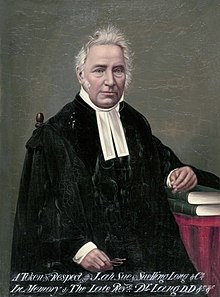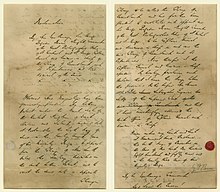Separation of Queensland
The Separation of Queensland was an event in 1859 in which the land that forms the present-day
History
European settlement of Queensland began in 1824 when Lieutenant

In the vanguard of those seeking representative government was the Reverend
Yet while they could reach consensus on the need for separation, whether a new colony would be free or unfree became a divisive issue. Lang and the majority of townspeople supporters favoured free immigration. The powerful

Among other things there was uncertainty over the location of a southern border. Lang was among many others who believed that the Northern Rivers should become part of a northern colony; the New South Wales Government disagreed, and when Queen Victoria finally signed the Letters Patent to create Queensland on 6 June 1859 at Osborne House,[2] the border was fixed at 28 degrees south.
The following month, unofficial news was received that the Secretary of State for the Colonies, Sir


Inclement weather intervened meaning Governor Bowen did not arrive until the evening of 9 December 1859. The following day Governor and Lady Bowen were welcomed by an estimated crowd of 4,000 exultant colonists when they stepped ashore at the Botanic Gardens in Brisbane.[3] They were then conveyed by carriage to the temporary Government House, a building which now serves as the deanery of St John's Cathedral. After ascending to the balcony, the resident Supreme Court Judge, Justice Alfred Lutwyche administered Governor Bowen's oath, after which the Queen's Commission was read to the assembled throng by the newly appointed Colonial Secretary, Robert Herbert. The formalities concluded with the proclamation of the Letters Patent being read by Governor Bowen's acting private secretary, Abram Moriarty, who was to become the new colony's first civil servant after being appointed Under Colonial Secretary on 15 December 1859.[1]
The Letters Patent were published in the inaugural issue of the Queensland Government Gazette on 10 December 1859, and this has given rise to confusion over whether 10 December 1859 should be remembered as Separation Day or Proclamation Day. The former may be preferred, for it was only with the publication of the Letters Patent in Queensland that separation became a legal reality, though it can be equally accepted that this was also an official proclamation of their content.[1]
On 10 December 1859, Bowen also appointed an Executive Council to operate as a provisional government until a parliament had been elected. Under the terms of separation, however, it was left for Sir William Denison, Governor of New South Wales, to appoint 11 members to the first Queensland Legislative Council in May 1860 for a term of five years. Bowen was to appoint their successors for life, and from the outset the nominee character of the Upper House proved highly unpopular. Attempts to amend the Constitution to make the Upper House elected were to continue until the Legislative Council was finally abolished in 1922.[1]
However, the
Commemoration
Queensland Day is celebrated on 6 June every year, the anniversary of Queen Victoria signing the Letters Patent to create Queensland on 6 June 1859.
Separation Day was celebrated as a public holiday on 10 December from 1860 to 1920.[5]
In 2009, Queensland celebrated its sesquicentenary, known as Q150.
In 2009, as part of the
See also
References
- ^ State of Queensland. Archivedfrom the original on 23 April 2019. Retrieved 10 February 2015.
- ^ David Gibson (10 December 2015). "Proclamation Day, when Queensland became a new colony". Brisbane Times. Fairfax Media. Archived from the original on 14 February 2017. Retrieved 2 February 2016.
- The Moreton Bay Courier. Vol. XIV, no. 810. Queensland, Australia. 13 December 1859. p. 2. Archivedfrom the original on 25 February 2022. Retrieved 13 February 2017 – via National Library of Australia.
- ^ "The birth of modern Queensland". Queensland State Archives. 19 November 2015. Archived from the original on 14 March 2016. Retrieved 2 February 2016.
- ^ Roberts, Katy (9 December 2016). "Separation Day: the "true birth of Queensland"". State Library of Queensland. Archived from the original on 11 May 2021. Retrieved 25 February 2022.
- ^ Bligh, Anna (10 June 2009). "PREMIER UNVEILS QUEENSLAND'S 150 ICONS". Queensland Government. Archived from the original on 24 May 2017. Retrieved 24 May 2017.
Attribution
External links
- "Item ID1431975, The Proclamation of Queensland document". Queensland State Archives. Retrieved 10 February 2015. — images of original handwritten document
- "Item ID1431995, Transcript of the Proclamation of Queensland document". Queensland State Archives. Retrieved 10 February 2015. — images of transcription

